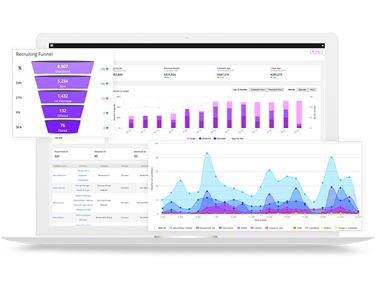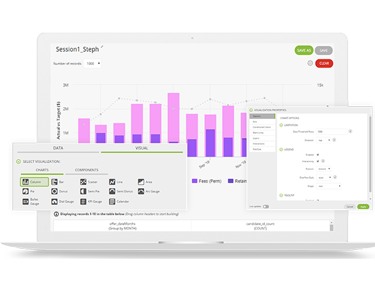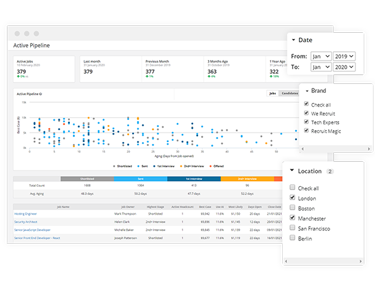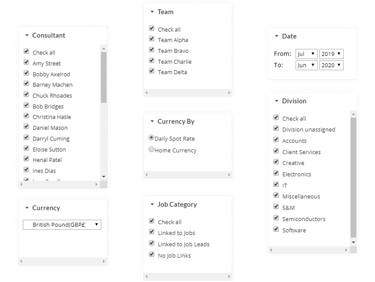AI Recruitment CRM
Build stronger relationships, boost leads, and manage recruitment from one smart platform.
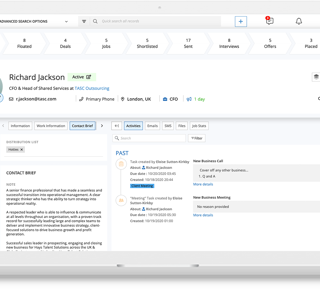
Vincere Intelligence, part of the Access Vincere Evo suite, puts real-time recruitment analytics software at your fingertips, so you can see what’s working, fix what’s not, and drive performance at every stage of the recruitment funnel. From consultant activity to forecasted revenue, get instant answers with built-in dashboards, AI-powered insights, and zero guesswork.

Recruitment analytics turns your data into smarter decisions. It helps you track every stage of the funnel—like where your best candidates come from, how long roles take to fill, and which consultants are delivering the most impact.
With Vincere Evo, you get intelligent dashboards and AI-powered reporting tools that give you a complete, real-time view of your pipeline—and the clarity to focus on what moves the needle.
Imagine if your recruitment tech could do more than just store data—what if it could think, learn, and act alongside your team? Access Vincere Evo is your AI-powered growth engine that automates the admin, surfaces insights in seconds, and helps your consultants focus on what really matters: making more placements and scaling your business.
Spot bottlenecks, drop-offs, and underperformers before they impact performance. Access Vincere Evo’s Intelligence module includes 50+ pre-built dashboards, plus the flexibility to customise your own, all at the touch of a button. So, you can see exactly what’s happening, why it matters, and where to act next.
Combine Access Vincere Evo’s Intelligence with our AI recruitment coach and empower your agents to make data-driven decisions and move forward, faster.
With 150+ data sources ready to go, Access Vincere Evo lets you create tailored dashboards to your liking, no devs, no delays. Visualise your metrics your way with flexible chart types, drag-and-drop builders, and intelligent filters that keep your business sharp and your strategy focused.
Smarter insights equals stronger performance. Give your team the clarity to coach, optimise, and scale, all powered by Access Vincere Evo. With AI forecasting, performance tracking, and real-time fee reporting built directly into your recruitment CRM, there’s no guesswork, just growth.
Your CRM is only as powerful as the data inside it. Access Vincere Evo scores and visualises your database health, flagging gaps, duplicates, and hygiene issues in real-time. Hold 'Top Offenders' accountable, incentivise clean data habits, and keep your team audit-ready, search-smart, and performance-primed.
Access Vincere Evo’s dynamic filters let you drill into your data instantly by brand, team, consultant, division, or date range. Whether you're slicing by job category, location, or currency, you always get the answers you need, exactly when you need them.
Put your team’s performance on display with live TV dashboards that highlight top billers, funnel progress, and activity metrics in real time. Tap into recruiters’ natural drive to compete and turn visibility into motivation that moves the needle.
What gets seen, gets done.
Recruitment analytics is defined as the application of data science in the recruitment field to enhance the efficiency of the recruitment cycle. It involves tracking, measuring, collating, and analyzing data to make better decisions.
For example:
At the basic level, data collected is mainly used for reports. Moving to a more advanced one, insights from such reports are invaluable assets that greatly help in planning and optimizing the recruitment process. This allows for a complete transformation of recruiting – from revolving around gut-feeling decisions to being based on real data and evidence.
Data science has left its footprints in a multitude of areas in the past decade, including recruiting. Recruitment analytics provide the basis for predictive analysis and insightful information that help skyrocket the efficiency of your sourcing, interviewing, selecting, and other staffing activities.
Recruitment analytics provide a plethora of data that act as basis for better decision making. By interpreting the information collected, recruiters have an improved chance of deducing if their business is being operated in the right way.
Enhance business efficiency
Data analytics in recruitment help staffing businesses spot opportunities to improve the recruiting process – as well as any problems that are hindering the team’s overall productivity. This allows for a reduction in the cost of total budget – as well as a potential improvement in time-to-hire.
Improve the allocation of budget
Identifying bottlenecks in the recruiting process is crucial to detecting ineffective channels – so that the team can allocate budget to more effective ones that bring in better qualified candidates.
Track performance of recruiting personnel
It is possible to assess each candidate's job quality by utilizing data science during the recruitment process. This enables staffing business owners to evaluate their team members' performance - and provide them with guidance on how to boost their own output.
According to the Future of Recruiting report by LinkedIn, leveraging data effectively is one of the top five priorities for recruiting over the next 5 years. Knowing which information to focus on may provide an enormous advantage for recruiters.
Here, we have compiled a list of the most crucial recruitment analytics metrics.
1. Source
Measuring the efficacy of your sourcing platforms is vital to the recruiting process. In order to save time and costs, your team must continually measure and find the most efficient channel. The time it takes for a platform to get the requisite number of applications, as well as the quality and quantity of those applicants, are all factors considered.
2. Time-to-fill
Time-to-fill refers to how long it takes to fill a position. This metric can give you information about the shortage of personnel for this position - as well as, somewhat, the effective level of the recruitment team. However, it is quite tricky to measure - as it ends when a candidate accepts a position. But when does it start? When the recruitment manager signs the document, or when the team uploads job postings?
3. Interview-to-placement ratio
This recruitment analytics metric measures the proportion of interviewed applicants that receive offers. It is a very strong signal of how well your recruiting is performing - specifically, how efficient and effective their sourcing and screening activities are. To cut down on costs - and save time for clients, recruiters should constantly evaluate their interview-to-placement ratios - so as to determine any impeding loohoples in the process, and any ideas for improvement.
4. Diversity
Diversity indicates the variety of your candidates. There are many reasons for staffing businesses to pay attention to this factor. Diversity of the workforce enhances productivity, innovation, and financial performance – which is all what your clients desire.
5. Cost per candidate
Cost per candidate refers to the amount of money you spend on one applicant. This number will help you allocate reasonable costs for each step in the recruiting cycle.
6. Applicants per job
This recruitment analytics metric could indicate how effective the recruiting team is, or a problem your job description might have (for example, too vague). Adjusting the number (and quality) of applicants can save you time at the screening step.
7. Quality of candidate
Quality of candidate is measured by a combination of metrics. Essentially, it tells recruiters if they have chosen the right applicant for their clients. In order to decide if a candidate is qualified, you need to assess various aspects - staring from the pre-hire phase:
As well as the post-hire stage:
8. Candidate experience
Whether online or offline, optimizing and measuring the candidate experience is extremely important. An applicant with good experience will be open to leaving good reviews – as well as more willing to contribute to your clients. This, in turn, is a great stepping stone to establishing yourself as a trustworthy recruiter.
Below, we have compiled some of the best practices to optimize your recruitment process with data analysis:
Make use of the right data
According to the Future of Recruiting report by LinkedIn, the most valuable recruitment analytics metrics are being overlooked. Quality of hire is in the top 1. While 88% of recruiters agree this metric will be the most useful in the near future, only 48% actually use it. Other overlooked metrics include sourcing channel effectiveness, hiring time, and cost per hire.
Different levels require focus on different metrics. For example, entry-level jobs need to recruit people regularly, but management-level positions have less selection and opportunities. Measuring applicants-per-hire for fresher positions makes more sense, while management positions focus on quality-of-hire.
Visualize your data
Visualizing data helps recruiters detect trends from the data, thereby recognizing areas for improvement in the recruiting process. When working with huge volumes of data, using a recruitment dashboard to keep track of your metrics can help reduce the time - and obtain more accurate results.
Platforms like Vincere are designed with a wide variety of templates and customized metrics for you to choose from.
Implement insights into the recruiting process
The ultimate goal of recruitment analytics is to uncover meaning from the data - and make changes to optimize the recruiting process.
For example, if your candidates per hire are low, your job description could be overly imprecise, or your platforms are unsuitable.
Towards a data-driven planning
Data analytics are not only used to evaluate past or present activities; they can be used to predict the future too. Using data to plan for the future can help allocate businesses budgets, predict opportunities, and anticipate potential risks. Get a detailed overview of data-driven recruitment strategies.
To apply recruitment analytics, staffing businesses need to find the right software for themselves. Vincere is an all-in-one recruitment agency software that integrates tons of features to help the recruitment team monitor the hiring process – as well as to keep track of the team’s performance. Our analytics tool – Vincere Intelligence – comes with a library of 50+ dashboards, 150+ data sources for custom reports, and various pre-built features for recruiters to acquire practical insights – so that they can improve their decision-making capability.
